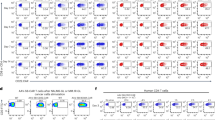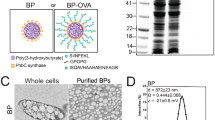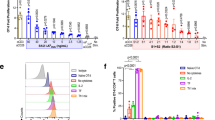Abstract
Genetically modified dendritic cells (DC) constitute a promising approach in cancer immunotherapy. Viral gene delivery systems have been shown to be very efficient strategies, but safety concerns for their clinical use in immunotherapy remain an important issue. Recently, the technique of mRNA electroporation was described as a very efficient tool for the genetic modification of human monocyte-derived DC. Here, we show that transgene expression can be modulated by varying the amount of mRNA used for electroporation. We document that CD40 ligation leads to a significant production of IL-12 by the electroporated DC, although the level of IL-12 production is somewhat lower than for non- or mock-electroporated DC. Furthermore, we show that the electroporated DC can be frozen and thawed without loss of viability or function and that Influenza virus Matrix Protein 1 mRNA electroporated DC are capable of inducing a memory cytotoxic T lymphocyte response and are more potent in doing so than mRNA-pulsed DC. Similar results were obtained with MelanA/MART-1 mRNA electroporated DC. These results clearly indicate that mRNA-electroporated DC represent powerful candidates for use as tumor vaccines and could constitute an improvement compared with vaccines using peptide-pulsed DC.
This is a preview of subscription content, access via your institution
Access options
Subscribe to this journal
Receive 12 print issues and online access
$259.00 per year
only $21.58 per issue
Buy this article
- Purchase on Springer Link
- Instant access to full article PDF
Prices may be subject to local taxes which are calculated during checkout







Similar content being viewed by others
References
Steinman RM . The dendritic cell system and its role in immunogenicity. Annu Rev Immunol. 1991;9:271–296.
Cella M, Sallusto F, Lanzavecchia A . Origin, maturation and antigen presenting function of dendritic cells. Curr Opin Immunol. 1997;9:10–16.
Banchereau J, Steinman RM . Dendritic cells and the control of immunity. Nature. 1998;392:245–252.
Bell D, Young JW, Banchereau J . Dendritic cells. Adv Immunol. 1999;72:255–324.
Banchereau J, Briere F, Caux C, et al. Immunobiology of dendritic cells. Annu Rev Immunol. 2000;18:767–811.
Guermonprez P, Valladeau J, Zitvogel L, et al. Antigen presentation and T cell stimulation by dendritic cells. Annu Rev Immunol. 2002;20:621–667.
Celluzzi CM, Mayordomo JI, Storkus WJ, et al. Peptide-pulsed dendritic cells induce antigen-specific CTL-mediated protective tumor immunity. J Exp Med. 1996;183:283–287.
Pardoll DM . Cancer vaccines. Nat Med. 1998;4:525–531.
Brossart P, Wirths S, Stuhler G, et al. Induction of cytotoxic T-lymphocyte responses in vivo after vaccinations with peptide-pulsed dendritic cells. Blood. 2000;96:3102–3108.
Schlienger K, Craighead N, Lee P, et al. Efficient priming of protein antigen-specific human CD4(+) T cells by monocyte-derived dendritic cells. Blood. 2000;96:3490–3498.
Chen CH, Wu TC . Experimental vaccine strategies for cancer immunotherapy. J Biomed Sci. 1998;5:231–252.
Hung K, Hayashi R, Lafond-Walker A, et al. The central role of CD4(+) T cells in the antitumor immune response. J Exp Med. 1998;188:2357–2368.
Gao FG, Khammanivong V, Liu WJ, et al. Antigen-specific CD4+ T-cell help is required to activate a memory CD8+ T cell to a fully functional tumor killer cell. Cancer Res. 2002;62:6438–6441.
Pardoll DM, Topalian SL . The role of CD4+ T cell responses in antitumor immunity. Curr Opin Immunol. 1998;10:588–594.
Wang RF . The role of MHC class II-restricted tumor antigens and CD4+ T cells in antitumor immunity. Trends Immunol. 2001;22:269–276.
Marzo AL, Kinnear BF, Lake RA, et al. Tumor-specific CD4+ T cells have a major "post-licensing" role in CTL mediated anti-tumor immunity. J Immunol. 2000;165:6047–6055.
Tobery TW, Siliciano RF . Targeting of HIV-1 antigens for rapid intracellular degradation enhances cytotoxic T lymphocyte (CTL) recognition and the induction of de novo CTL responses in vivo after immunization. J Exp Med. 1997;185:909–920.
Tobery T, Siliciano RF . Cutting edge: induction of enhanced CTL-dependent protective immunity in vivo by N-end rule targeting of a model tumor antigen. J Immunol. 1999;162:639–642.
Varshavsky A, Turner G, Du F, et al. Felix Hoppe-Seyler Lecture 2000. The ubiquitin system and the N-end rule pathway. Biol Chem. 2000;381:779–789.
Bonini C, Lee SP, Riddell SR, et al. Targeting antigen in mature dendritic cells for simultaneous stimulation of CD4+ and CD8+ T cells. J Immunol. 2001;166:5250–5257.
Lin KY, Guarnieri FG, Staveley-O'Carroll KF, et al. Treatment of established tumors with a novel vaccine that enhances major histocompatibility class II presentation of tumor antigen. Cancer Res. 1996;56:21–26.
Thomson SA, Burrows SR, Misko IS, et al. Targeting a polyepitope protein incorporating multiple class II-restricted viral epitopes to the secretory/endocytic pathway facilitates immune recognition by CD4+ cytotoxic T lymphocytes: a novel approach to vaccine design. J Virol. 1998;72:2246–2252.
Wu TC, Guarnieri FG, Staveley-O'Carroll KF, et al., Engineering an intracellular pathway for major histocompatibility complex class II presentation of antigens. Proc Natl Acad Sci USA. 1995;92:11671–11675.
Morgan RA, Anderson WF . Human gene therapy. Annu Rev Biochem. 1993;62:191–217.
Anderson WF . Human gene therapy. Nature. 1998;392:25–30.
Dietz AB, Vuk-Pavlovic S . High efficiency adenovirus-mediated gene transfer to human dendritic cells. Blood. 1998;91:392–398.
Robbins PD, Ghivizzani SC . Viral vectors for gene therapy. Pharmacol Ther. 1998;80:35–47.
Boczkowski D, Nair SK, Nam JH, et al. Induction of tumor immunity and cytotoxic T lymphocyte responses using dendritic cells transfected with messenger RNA amplified from tumor cells. Cancer Res. 2000;60:1028–1034.
Koido S, Kashiwaba M, Chen D, et al. Induction of antitumor immunity by vaccination of dendritic cells transfected with MUC1 RNA. J Immunol. 2000;165:5713–5719.
Irvine AS, Trinder PK, Laughton DL et al., Efficient nonviral transfection of dendritic cells and their use for in vivo immunization. Nat Biotechnol. 2000;18:1273–1278.
Li S, Huang L . Nonviral gene therapy: promises and challenges. Gene Ther. 2000;7:31–34.
Mitchell DA, Nair SK . RNA-transfected dendritic cells in cancer immunotherapy. J Clin Invest. 2000;106:1065–1069.
Nair SK, Heiser A, Boczkowski D, et al. Induction of cytotoxic T cell responses and tumor immunity against unrelated tumors using telomerase reverse transcriptase RNA transfected dendritic cells. Nat Med. 2000;6:1011–1017.
Strobel I, Berchtold S, Gotze A, et al. Human dendritic cells transfected with either RNA or DNA encoding influenza matrix protein M1 differ in their ability to stimulate cytotoxic T lymphocytes. Gene Ther. 2000;7:2028–2035.
Heiser A, Maurice MA, Yancey DR, et al. Human dendritic cells transfected with renal tumor RNA stimulate polyclonal T-cell responses against antigens expressed by primary and metastatic tumors. Cancer Res. 2001;61:3388–3393.
Van Tendeloo VF, Ponsaerts P, Lardon F, et al. Highly efficient gene delivery by mRNA electroporation in human hematopoietic cells: superiority to lipofection and passive pulsing of mRNA and to electroporation of plasmid cDNA for tumor antigen loading of dendritic cells. Blood. 2001;98:49–56.
Ponsaerts P, Van Tendeloo VF, Cools N, et al. mRNA-electroporated mature dendritic cells retain transgene expression, phenotypical properties and stimulatory capacity after cryopreservation. Leukemia. 2002;16:1324–1330.
Kalady MF, Onaitis MW, Padilla KM, et al. Enhanced dendritic cell antigen presentation in RNA-based immunotherapy. J Surg Res. 2002;105:17–24.
Tuyaerts S, Noppe M, Corthals J, et al. Generation of large numbers of dendritic cells in a closed system using cell factories. J Immunol Methods. 2002;264:135–151.
Boczkowski D, Nair SK, Snyder D, et al. Dendritic cells pulsed with RNA are potent antigen-presenting cells in vitro and in vivo. J Exp Med. 1996;184:465–472.
Morel S, Levy F, Burlet-Schiltz O, et al. Processing of some antigens by the standard proteasome but not by the immunoproteasome results in poor presentation by dendritic cells. Immunity. 2000;12:107–117.
Van den Eynde BJ, Morel S . Differential processing of class-I-restricted epitopes by the standard proteasome and the immunoproteasome. Curr Opin Immunol. 2001;13:147–153.
Ashley DM, Faiola B, Nair S, et al. Bone marrow-generated dendritic cells pulsed with tumor extracts or tumor RNA induce antitumor immunity against central nervous system tumors. J Exp Med. 1997;186:1177–1182.
Van Meirvenne S, Straetman L, Heirman C, et al. Efficient genetic modification of murine dendritic cells by electroporation with mRNA. Cancer Gene Ther. 2002;9:787–797.
Acknowledgements
We thank Christine Huysmans, Danny Carels and Katja Michielsen for the help with DC cultures, Elsy Vaeremans and Peggy Verbuyst for the mRNA preparation, Karolien Claes for performing IFNγ-ELISPOT assays and Jos Theunissen for useful discussions.
This work was supported by grants to K T from the Fund for Scientific Research-Flanders (FWO-Vlaanderen), the Institute for Science & Technology (IWT), the Ministry of Science (IUAP/PAI IV), the FORTIS Bank and De Belgische Federatie voor Kankerbestrijding.
Author information
Authors and Affiliations
Corresponding author
Rights and permissions
About this article
Cite this article
Tuyaerts, S., Michiels, A., Corthals, J. et al. Induction of Influenza Matrix Protein 1 and MelanA-specific T lymphocytes in vitro using mRNA-electroporated dendritic cells. Cancer Gene Ther 10, 696–706 (2003). https://doi.org/10.1038/sj.cgt.7700622
Received:
Published:
Issue Date:
DOI: https://doi.org/10.1038/sj.cgt.7700622
Keywords
This article is cited by
-
Langerhans-type and monocyte-derived human dendritic cells have different susceptibilities to mRNA electroporation with distinct effects on maturation and activation: implications for immunogenicity in dendritic cell-based immunotherapy
Journal of Translational Medicine (2013)
-
Efficient large volume electroporation of dendritic cells through micrometer scale manipulation of flow in a disposable polymer chip
Biomedical Microdevices (2011)
-
Enhancing the T-cell Stimulatory Capacity of Human Dendritic Cells by Co-electroporation With CD40L, CD70 and Constitutively Active TLR4 Encoding mRNA
Molecular Therapy (2008)
-
Studies on mRNA Electroporation of Immature and Mature Dendritic Cells: Effects on their Immunogenic Potential
Molecular Biotechnology (2008)
-
mRNA-based cancer vaccine: prevention of B16 melanoma progression and metastasis by systemic injection of MART1 mRNA histidylated lipopolyplexes
Cancer Gene Therapy (2007)



